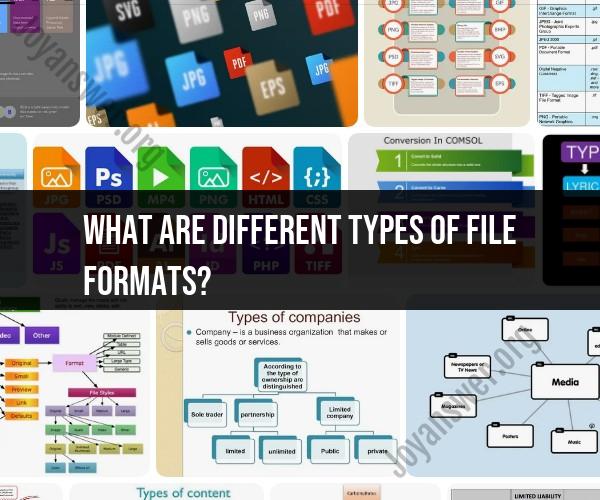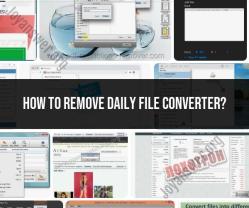What are different types of file formats?
There are numerous file formats used for digital data, each designed for specific types of information and applications. Here are some common types of file formats and their typical uses:
Text Formats:
- TXT: Plain text files contain unformatted text and are used for basic documents.
- DOCX, DOC: Microsoft Word document formats.
- PDF: Portable Document Format is used for documents that need to maintain their formatting across various platforms.
Image Formats:
- JPEG (JPG): Used for photographs and images with continuous tones.
- PNG: Suitable for images with transparency or high-quality graphics.
- GIF: Used for simple animations and images with limited colors.
- BMP: Uncompressed format used for high-quality images.
- TIFF: Used for high-resolution and lossless images.
Audio Formats:
- MP3: Compressed audio format known for its small file size while maintaining audio quality.
- WAV: Uncompressed format known for high audio quality.
- AAC: Commonly used for iTunes and Apple devices.
- FLAC: Lossless audio format that retains high quality.
- MIDI: Used for musical instrument data.
Video Formats:
- MP4, AVI, MOV: Common video file formats used for a variety of purposes.
- MKV: Known for its versatility in containing video, audio, and subtitles.
- WMV: Developed by Microsoft for Windows Media Player.
- FLV: Used for web video content.
Compressed Archives:
- ZIP: Commonly used for compressing and archiving files and folders.
- RAR: Used for compressing files and can be password-protected.
- 7z: Offers high compression ratios and is open-source.
Spreadsheet Formats:
- XLSX, XLS: Microsoft Excel spreadsheet formats.
- CSV: Comma-Separated Values, commonly used for data exchange.
- ODS: Open Document Spreadsheet format used in open-source office suites.
Presentation Formats:
- PPTX, PPT: Microsoft PowerPoint presentation formats.
- PDF: Can be used for presentations to maintain formatting.
Ebook Formats:
- EPUB: Standard format for ebooks, supported by many e-readers.
- PDF: Used for ebooks, particularly for fixed-layout or print-ready books.
- MOBI: Amazon Kindle ebook format.
Database Formats:
- SQL: Contains structured query language for relational databases.
- CSV: Often used for data export/import between databases.
Programming and Code Formats:
- C, C++, Java, Python: Programming languages have their own source code file formats.
- HTML, CSS, JavaScript: Web development languages with their own file formats.
3D Graphics and Modeling Formats:
- STL: Used for 3D printing.
- OBJ: Common 3D model file format.
- FBX: Used for 3D modeling and animation interchange.
Document and Data Exchange Formats:
- XML: Extensible Markup Language for structured data.
- JSON: JavaScript Object Notation for data interchange.
- CSV: Common for exchanging tabular data.
- XLSX: Microsoft Excel format for data exchange.
These are just a few examples of the many file formats used for different types of digital data. The choice of format often depends on the specific use case, compatibility with software or hardware, and the desired balance between file size and data quality.
Exploring Different Types of File Formats
A file format is a way of storing digital data so that it can be interpreted by a computer or other device. There are many different types of file formats, each with its own advantages and disadvantages.
What are the most common image file formats?
The most common image file formats are:
- JPEG (Joint Photographic Experts Group): JPEG is a lossy image format, which means that some data is lost when the image is compressed. However, JPEG images are typically very small in size, making them ideal for sharing online or storing on devices with limited storage space.
- PNG (Portable Network Graphics): PNG is a lossless image format, which means that no data is lost when the image is compressed. PNG images are typically larger in size than JPEG images, but they are also of higher quality.
- GIF (Graphics Interchange Format): GIF is a lossless image format that is commonly used for animated images. GIF images are typically small in size and can be displayed on most devices.
Understanding Audio File Formats: Which one to choose?
The most common audio file formats are:
- MP3 (MPEG-1 Audio Layer 3): MP3 is a lossy audio format that is commonly used for sharing music online. MP3 files are typically very small in size, but they may not be of the highest quality.
- WAV (Waveform Audio File Format): WAV is a lossless audio format that is commonly used for recording and storing audio. WAV files are typically much larger in size than MP3 files, but they are also of higher quality.
- FLAC (Free Lossless Audio Codec): FLAC is a lossless audio format that is similar to WAV, but it compresses the audio data to reduce the file size. FLAC files are typically smaller than WAV files, but they are still of the same quality.
Document File Formats: PDF, DOC, DOCX, and more
The most common document file formats are:
- PDF (Portable Document Format): PDF is a non-proprietary file format that is commonly used for sharing documents. PDF files can be opened on most devices and are difficult to edit, making them ideal for sharing documents that need to remain unchanged.
- DOC and DOCX (Microsoft Word Document): DOC and DOCX are proprietary file formats that are used by Microsoft Word. DOCX is the newer format and is more compatible with newer versions of Microsoft Word.
- TXT (Text File): TXT is a simple text file format that can be opened by any text editor. TXT files are typically very small in size and are easy to share.
Video File Formats: Which one is right for your needs?
The most common video file formats are:
- MP4 (MPEG-4 Video): MP4 is a lossy video format that is commonly used for sharing videos online. MP4 files are typically very small in size, but they may not be of the highest quality.
- MOV (QuickTime Movie File Format): MOV is a lossless video format that is commonly used for recording and storing video. MOV files are typically much larger in size than MP4 files, but they are also of higher quality.
- AVI (Audio Video Interleave): AVI is a lossless video format that is commonly used for recording and editing video. AVI files are typically much larger in size than MP4 files, but they are also of higher quality.
Which file format is right for you depends on your needs. If you need to share a file online or store it on a device with limited storage space, then you should choose a compressed format such as JPEG, MP3, or MP4. If you need to preserve the quality of the file, then you should choose a lossless format such as PNG, WAV, FLAC, MOV, or AVI.












